If Frodo and Sam had ridden steel-framed steeds to Mordor, what would their bikepacking bag setup have looked like? It’s a question that has ruined many a night’s sleep. Thus, today I’m sharing five of my favourites in the fight against Sauron.

Carradice Saddlebag
Much like Po-tay-toes! Boil ’em, mash ’em, stick ’em in a stew, the Carradice Saddlebag is the staple ingredient in all my bikepacking adventures. I have two models, the Long Flap Camper, and Super C. They are both handmade in the UK using 100-percent waterproof waxed 18-ounce cotton duck (a heavy, plain, woven cotton fabric), feature two generous external pockets, and have a large easy access central flap (although the Super C incorporates glove-friendly, quick-release buckles instead of the Longflap’s leather straps). The bags are very similar, but there can only be one saddlebag to rule them all, and that’s the Longflap Camper. It is the bigger of the two bags at 24 litres, compared to the Super C’s 23 litres, and whilst one litre may seem negligible, on the bike, it’s a huge deal. Moreover, thanks to its innovative extendable flap, capacity is increased further.
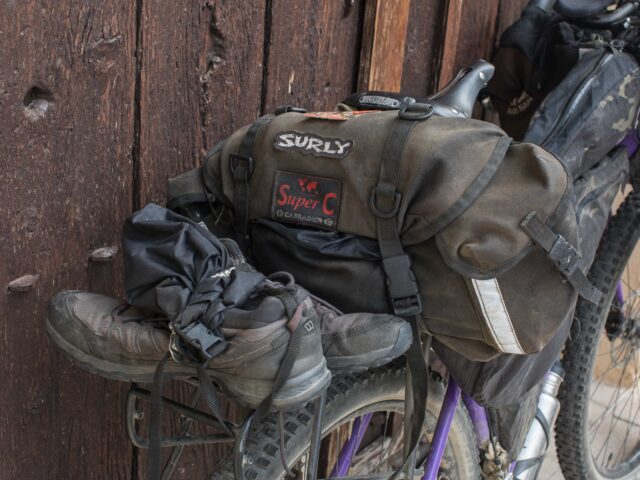
I have tested various saddle compression packs over the years. I like the concept, but have found that a saddlebag is generally more convenient since accessing items in seat packs is more laborious). Sure, some would say, Argh! What’s he doing! Stupid fat hobbit, why not use the saddle pack for items you don’t need regularly? Well, Smeagol, spare your judgement. I like the flexibility to adjust my storage as the day goes on, and crucially, a saddlebag gives me unparalleled quick access to cameras, gimbals, and my Mithril shirt when things get dicey. Ultimately, on an extended bikepacking trip, I want the most versatile arrangement possible. A bomb-proof saddlebag combined with a sturdy rear rack offers limitless ways to store and strap down the spoils of war.
$131 | carradice.co.uk
Pros
High capacity
Easy access
Weatherproof
Extremely durable
Good value
Large side pockets.
Cons
Requires a support/rack when loaded
Wider, more cumbersome than a seat pack
Alternatives: Wizard Works, Shazam! Saddle Bag (wizard.works); Bags by Bird, Goldback, Large (bagsxbird.com); Rons Bikes, Fabio’s Waxed Chest (ronsbikes.com)
![]()
![]()
Top Tube Storage
Bikepacking has revolutionised the way we think about transporting gear on a bicycle, and any wasted space is quickly replaced with an ingenious bag. The Top Tube previously spent its days basking in the sun and, quite frankly, not pulling its weight. However, companies such as Revelate Designs and J Paks realised that in The Battle for Middle Earth, riders would need quick access to mobile phones (to call in reinforcements), loose change (for the Rivendell 7-Elve-en…oh come on, that was good), more stinkin’ Lembas bread, and various other trinkets. Traditional panniers may be cumbersome, but they are undeniably capacious, and a saddlebag/handlebar system will struggle to carry all the essentials. Thus, the extra storage offered by these bags helps make up the difference.
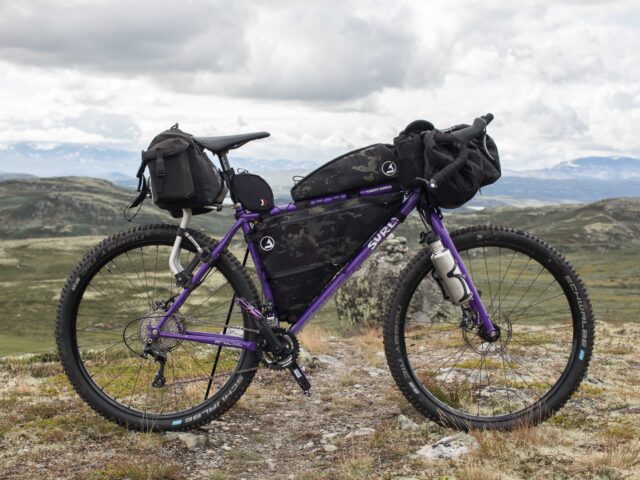
The Revelate Design Jerry Can is a nifty solution that fits between the seat and top tube and turns this previously wasted space into 0.6 litres of usable real estate. The build quality is nothing short of Elven, and despite years of abuse, it remains a dependable companion on trips such as this. However, when it comes to utilising wasted Top Tube space, there is a ranger among them, and he goes by the name of Joe Tonsager. In the Misty Mountains of Colorado lies J Paks, a bespoke bag maker responsible for the truly magical FarvaPak. This top-tube, mounted product offers a whopping 1.6-litre capacity (foot-long version) and is big enough to store my Mavic Pro Drone, controller, snacks, multi-tool, and camera film/accessories. The Jerry Can/FarvaPak combo creates an impressive 2.2 litres of storage in a location that’s optimum for easy access.
$ varies | jpaks.com
Pros
“Cockpit” location offers ultimate access on the move
Centralised, streamlined design
Great use of wasted space.
Cons
There’s not a tonne of padding in the bag’s base, so fragile items will be hitting the top tube on the rough stuff. I wrecked a drone this way—Fool of a Took!
Alternatives: ATM Handmade Goods, Rear TT Sack (andrewthemaker.com); Nittany Mountain Works, Stem Sack XL (nittanymountainworks.com); Alpine Luddites, Top Tube Bag (alpine-luddites.myshopify.com)
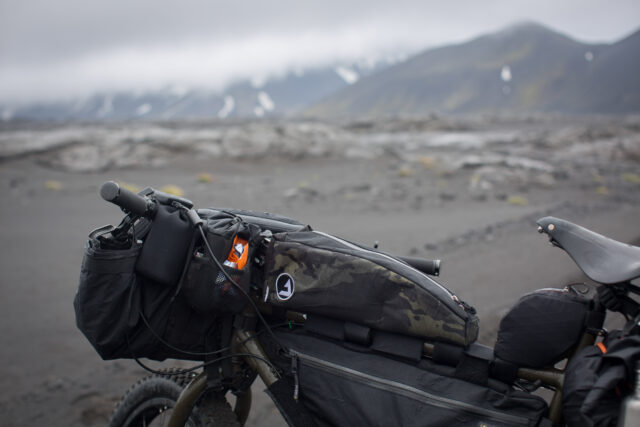
Frame Bag
The frame bag is one of the most distinctive characteristics of a bikepacking setup, utilised by most riders (in varying formats). If there’s one bag that maximises wasted space more than any other, it’s the frame bag. There are a number of universal offerings available (from the Realms of Revelate Designs, Alpkit, Blackburn Designs, Ortlieb, Restrap, and others), and many smaller companies offer a tailor-made option to ensure a perfect fit.
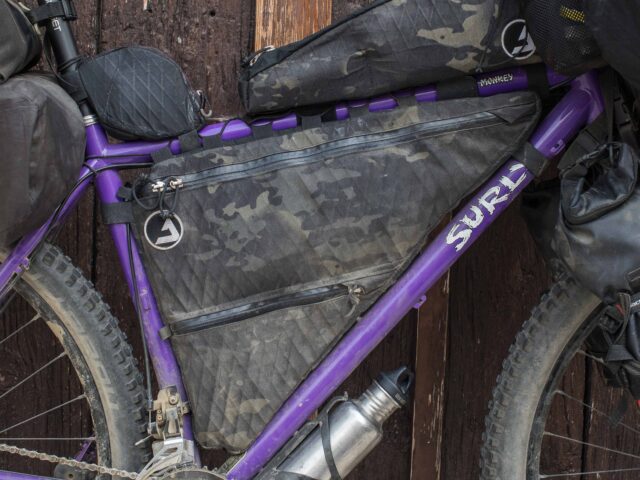
Well, he saved us once, and he’s back again; it’s Strider. Sorry, I mean Joe from J Paks. One of the best parts of working with a smaller bespoke service is you’re able to design your perfect bag. I opted for a full-frame option (some allow for bottle cages) that is divided into two half-sized compartments and a full-width ‘garage’ section in the base. Joe reduces the use of abrasive velcro attachments by utilising bottle braze-ons on the down tube and an elasticated cord along the top tube.
Moreover, the bag flares out towards the head tube to maximise space without impairing pedalling. The quality is superb, it protects my possessions from the elements, and it offers quick access to arrows in the event of an Orc ambush. Moreover, it’s genuinely remarkable how much space it affords, and even more wild when you consider this location was previously neglected.

There are various arguments for and against different bikepacking setups, but it’s hard to think of any scenario where you’d completely omit some version of a frame bag. Maybe, just maybe, this is the bag to finally unite the Realms of Men, elves, dwarves, and hobbits—perhaps even roadies and mountain bikers!
$ varies | jpaks.com
Pros
Ultimate use of wasted space
Lightweight
Accessible on the move
Tailored fit
Customisable to needs
Excellent quality.
Cons
Hard to fault as most independent bike bag manufacturers can tailor your frame bag to your exact requirements. If you see a fault with any given design, have it altered to your specification.
Alternatives: Porcelain Rocket, 52 HZ (porcelainrocket.com); Wildcat Gear, Frame Bags (wildcat.cc); Revelate Designs, Frame Bags (revelatedesigns.com)
Handlebar Bag
Traditionally, this literally meant a bag secured to the handlebars (such as Ortlieb’s Ultimate Six, Brooks’ Cornwall, or Velo Orange’s Randonneur). However, bikepacking introduced a wave of new configurations that varied from the traditional handlebar bag to more intricate harness arrangements. I still enjoy the aesthetic of classic bags, but storage is limited, and on technical terrain, they can be more unwieldy. A harness-based system offers increased storage, is exceptionally secure, and mounts neatly below/in-line with the handlebars (keeping weight low and close to the bike, which is advantageous for rough trails).

The first system I used was a harness and dry-bag combo, i.e., you’d stuff the dry bag with gear, then the harness would tightly secure the equipment to the bike. I wasn’t a big fan of this configuration. Firstly, much like a seat pack, the dry bag is compressed and then tightly secured in the harness. This is okay if you require occasional access but tiresome if you need it frequently. Moreover, the contents had to be very evenly distributed to prevent the bag from sagging or becoming loose as the day went on.
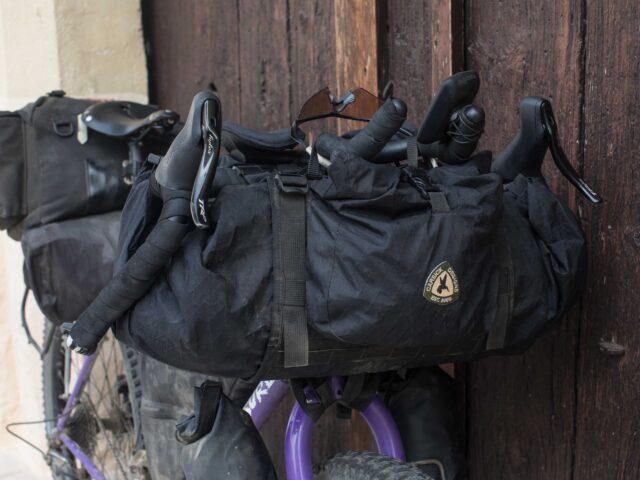
I was hoping that a company from the Realms of Men would come forth and present a system that integrated the harness and dry bag. Well, Carsick Designs did just that, and so much more. The Handee Randee is not merely a harness/dry-bag combo; alternatively, it’s a sophisticated all-in-one hybrid bag that offers excellent usability whilst maintaining a stable harness-based structure. The clue’s in the name Handee (Handlebar or handy) Randee (randonneur); it’s a combination between a bikepacking harness and a classic randonneuring bag. The HR features two large entry points and a front pocket, secured using a roll-top and buckle combination. The beauty of the roll-top is that you can drastically increase or decrease the size of the bag depending on your ride and objectives. Another generous feature is the two included Goodie Bags, or Feed Bags, which seamlessly integrate into either side of the headset to create bonus storage that’s accessible on the move. I use this bag for every bikepacking adventure I take and wouldn’t be caught without it.
$240 | carsickdesigns.com
Pros
High capacity
Excellent quality
Dual openings
Daisy chain webbing makes it adaptable to a range of handlebars, great for attaching accessories.
Cons
Designed for Jones H Bar/Surly Moloko (although I’ve had no issues on a standard MTB handlebar), an all-in-one system means you can’t remove the dry bag at the end of the day (you’d have to remove the entire bag).
Alternatives: Rons Bikes, Fabio Chest (ronsbikes.com); Swift Industries, Zeitgeist Bag (builtbyswift.com); Revelate Designs, Sweetroll (revelatedesigns.com)
Front Fork Cage/Dry Bag
What about elevenses? Luncheon? Afternoon tea? Dinner? Supper? Bikepackers, like hobbits, have an insatiable hunger, and I’ve learnt the hard cost of not bringing along enough food. Whether it’s sustenance, clothes, tools, or well, anything, as the Salsa Anything Bag suggests, the fork-mounted cage/dry bag combo is a great way to maximise storage without jeopardising riding control on challenging surfaces. Traditional front panniers offer huge amounts of space but make handling cumbersome on rough terrain. Moreover, hike ‘a’ biking the Stairs of Cirith Ungol with four panniers would be murder.
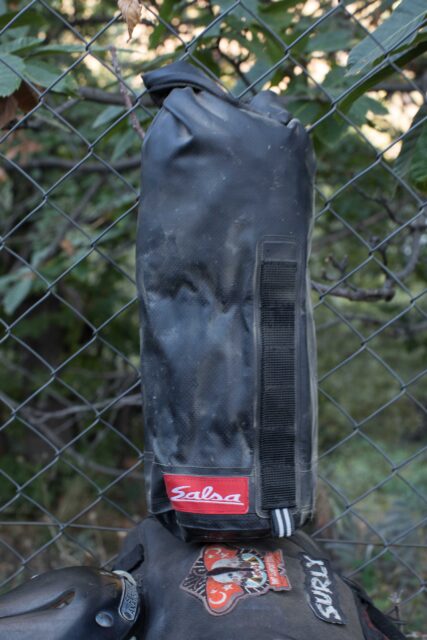
Alternatively, a cage/dry bag retains storage on the forks without making the bicycle completely uncooperative when you’re forced to carry it—now that’s juicy sweeeet! The most iconic option is undoubtedly the Salsa Anything Cage and their Anything bag. However, at the time, I was living off things I could find in the garden and opted for the more cost-effective Blackburn Outpost Cage and a Snugpak 4l Dri-Sak. The Outpost is a genuinely brilliant product and has remained with me since, whilst the Dri-Sak material was not fit for my purpose. Thus, I invested in the Salsa Anything bags and can confirm they’re as good as the hype. These bags have a hard life, so they’re not optimum for delicate items such as electronics. I use mine for socks, underwear, waterproofs, inner tubes, and any other low-cost item that I don’t need regularly. This storage solution, much like a frame bag, is almost weightless when empty. Thus, I like to fit the cages and bring along the Anything bags regardless of whether I think I’ll need them, and rest easy knowing I have additional storage should I need to carry additional supplies. For what? The journey home, of course.
$32 | blackburndesign.com
$35 | salsacycles.com
Pros
Minimal impact on handling
Super durable
Multi-purpose
Easy to remove or secure
Cons
Reduced capacity when compared to traditional panniers
Alternatives: Bedrock Vishnu, Multi-Use Bag (bedrockbags.com), Salsa, Anything Cage HD (salsacycles.com); ATM Handmade Goods, Many Things Sack (andrewthemaker.com), Widefoot, CargoMount (widefoot.com)


